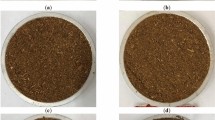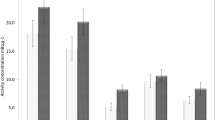Abstract
The activity concentrations of 238U, 232Th, 40 K and 137Cs radionuclides in 25 samples of tobacco leaves grown in Turkey have been measured using a high purity co-axial germanium detector. The measured activity concentrations for 238U ranged from 3.6 to 22.5 Bq kg−1 with an average of 9.8 Bq kg−1, for 232Th from 0.8 to 11.0 Bq kg−1 with an average of 2.4 Bq kg−1, and for 40 K from 360.3 to 1,479.5 Bq kg−1 with an average of 810.0 Bq kg−1. The concentrations of 137Cs, the residue of fallout from the Chernobyl reactor accident, were found to range from 0.2 to 2.1 Bq kg−1 with an average of 0.5 Bq kg−1. The results indicate that the average activity concentrations of 238U and 232Th lie within the range of measured values worldwide, whereas for 40 K the average was found to be higher. The average annual effective radiation doses from the inhalation of the corresponding tobacco smoke by an adult smoking 20 cigarettes per day was deduced to be 93.3 μSv y−1 for 238U, 193.2 μSv y−1 for 232Th, 5.6 μSv y−1 for 40 K, and 292.1 μSv y−1 in total. The average annual effective dose from 137Cs was calculated to be 8.5 nSv y−1. The resulting average annual effective radiation doses of 0.3 mSv due to the inhalation of natural radiation sources in tobacco were compared with studies worldwide and found much smaller than the worldwide average effective dose of 1.26 mSv. It is concluded that smoking may contribute a non-negligible fraction to the annual effective dose depending on cigarette consumption and activity concentration in tobacco. This study is the first in which natural and anthropogenic radioactivity in tobacco in Turkey was measured. Therefore, it is considered as a baseline study. Further studies are needed to investigate the role of tobacco refinement in the observed reduction of 238U concentration of refined tobacco.




Similar content being viewed by others
References
Emmanuel AH, Terhemba KS, Becky AN (2012) Radioactivity of local tobacco and some selected brands of cigarettes. Int J Phys Sci 7(2):205–213
Gumushan H (1980) Tobacco refining process. U S Pat 4(183):364
International Commission on Radiological Protection (ICRP) (2012). Compendium of dose coefficients based on ICRP Publication 60. ICRP Publication, p 119
Kubalek D, Sersa G, Strok M, Benedik L, Jeran Z (2016) Radioactivity of cigarettes and the importance of 210Po and thorium isotopes for radiation dose assessment due to smoking. J Environ Radioact 155–156:97–104
Landsberger S, Lara R, Landsberger SG (2015) Non-destructive determination of uranium, thorium and 40K in tobacco and their implication on radiation dose levels to the human body. Radiat Prot Dosim 167(1–3):243–246
Obodovskiy I (2015) Fundamentals of radiation and chemical safety, 3rd edn. Elsevier, Amsterdam
Papastefanou C (2001) Radiological impact from atmospheric releases of 238U and 226Ra from phosphate rock processing plants. J Environ Radioact 54(1):75–83
Papastefanou C (2009) Radioactivity of tobacco leaves and radiation dose induced from smoking. Int J Environ Res Public Health 6(2):558–567
Public Health Agency of Turkey, Global Adult Tobacco Research (2012) Ministry of Health of Turkey. Report (2014) https://sbu.saglik.gov.tr/Ekutuphane/kitaplar/istaturk2012.pdf. Accessed 09 Jan 2019
Ridha AA, Hasan HA (2016) Cancer risk due to the natural radioactivity in cigarette tobacco. Sci Res Publ 4:54–65
Sahin L, Hafızoğlu N, Çetinkaya H, Manisa K, Bozkurt E, Biçer A (2017) Assessment of radiological hazard parameters due to natural radioactivity in soils from granite-rich regions in Kütahya Province. Turkey Isot Environ Health Stud 53(2):212–221
Shousha HA, Ahmad F (2012) Natural radioactivity contents in tobacco and radiation dose induced from smoking. Radiat Prot Dosim 150(1):91–95
Sönmez A (2014) An analysis of the world market for tobacco production and international trade and its importance for Turkey. In: Proceedings of International Academic Conferences, p 0702173
Steinhäusler F, Hofmann W, Pohl E, Pohl-Rüling J (1983) Radiation exposure of the respiratory tract and associated carcinogenic risk due to inhaled radon daughters. Health Phys 45(2):331–337
Tso TC, Harley N, Alexander LT (1966) Source of lead-210 and polonium-210 in tobacco. Science 153(3738):880–882
Turkish Atomic Energy Authority (TAEK) (2006) Türkiye’de Çernobil sonrası radyasyon ve radyoaktivite ölçümleri. Çernobil Serisi 6.
Tzortzis M, Tsertos H, Christofides S, Christodoulides G (2003) Gamma-ray measurements of naturally occurring radioactive samples from Cyprus characteristic geological rocks. Radiat Meas 37(3):221–229
United Nations Scientific Committee on the Effects of Atomic Radiation (UNSCEAR) (2000) Report to the General Assembly with scientific annexes, v. I. sources and effects of ionizing radiation.
United Nations Scientific Committee on the Effects of Atomic Radiation (UNSCEAR) (2008) Report to the General Assembly with scientific annexes v. I. Sources and Effects of Ionizing Radiation.
World Health Organization (WHO) Tobacco, Key facts (2022) https://www.who.int/news-room/fact-sheets/detail/tobacco. Accessed 15 August 2022.
Acknowledgements
This work was supported by the Istanbul University BAP Grant number 32235. The authors would like to thank TAPDK under the Republic of Turkey Ministry of Agriculture and Forestry for giving permission with document number 22710 to provide the tobacco samples, and SOCOTAB Yaprak Tutun Sanayi ve Ticaret A.S. for providing the tobacco samples.
Author information
Authors and Affiliations
Contributions
GA and NH contributed to sample preparation, measurement and data analysis. GA wrote the first draft. LS and EG contributed to the interpretation of the results and the discussion. EG was involved in reviewing and editing the final manuscript.
Corresponding author
Ethics declarations
Conflict of interest
The authors have no conflict of interest to declare that are relevant to the content of this article.
Additional information
Publisher's Note
Springer Nature remains neutral with regard to jurisdictional claims in published maps and institutional affiliations.
Rights and permissions
Springer Nature or its licensor holds exclusive rights to this article under a publishing agreement with the author(s) or other rightsholder(s); author self-archiving of the accepted manuscript version of this article is solely governed by the terms of such publishing agreement and applicable law.
About this article
Cite this article
Ağgez, G., Ganioğlu, E., Sahin, L. et al. Radiation doses due to smoking different types of tobacco leaves grown in Turkey. Radiat Environ Biophys 61, 615–622 (2022). https://doi.org/10.1007/s00411-022-00995-1
Received:
Accepted:
Published:
Issue Date:
DOI: https://doi.org/10.1007/s00411-022-00995-1




